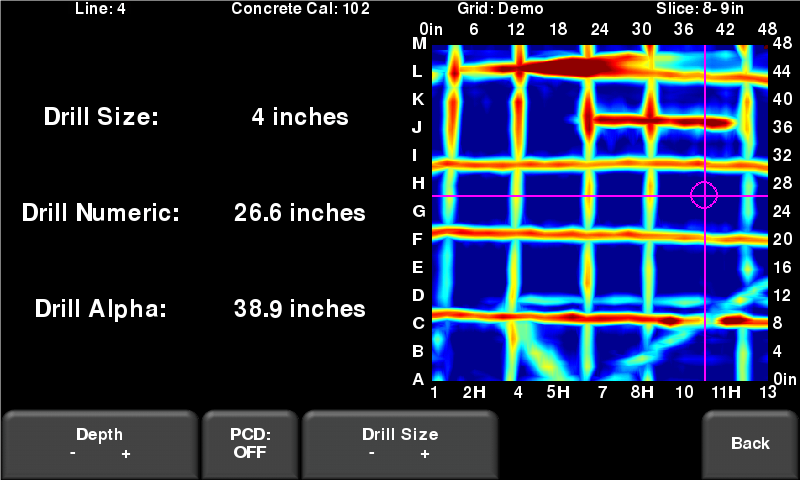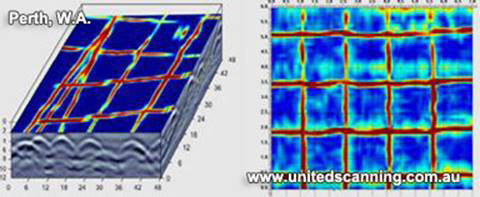Untangling the Under: Concrete Scanning and Imaging
Wiki Article
Past the Surface area: Deciphering the Keys of GPR Scanning for Concrete Applications
Are you prepared to dive deeper right into the globe of GPR scanning for concrete applications? Discover the essentials of GPR scanning, find out just how it functions, and discover ideal techniques for conducting scans on concrete surfaces.The Basics of GPR Scanning for Concrete Applications
GPR scanning is commonly used to assess the condition of concrete frameworks. You can easily unravel the keys that exist underneath the surface of the concrete when you use GPR scanning. It provides you with valuable details concerning the interior structure of the concrete and assists you determine any potential concerns or flaws.With GPR scanning, you can rapidly and non-destructively identify the thickness of the concrete slab and find any type of voids or delaminations within it - Concrete Scanning and Imaging. This info is essential for reviewing the architectural integrity of the concrete and preparing any type of necessary repair work or upkeep
Additionally, GPR scanning enables you to identify the visibility of strengthening steel bars, likewise referred to as rebar, within the concrete. This is necessary for assessing the stamina and longevity of the structure, in addition to for guaranteeing proper building and construction methods were followed.
In enhancement, GPR scanning can spot the visibility of moisture or water seepage within the concrete. This is particularly crucial as dampness can result in deterioration of the reinforcing steel, which can endanger the structural integrity of the concrete gradually.

Comprehending the Innovation Behind GPR Scanning
To recognize just how it functions, you require to comprehend the modern technology behind GPR scanning. Ground Passing Through Radar (GPR) is a non-destructive screening approach that utilizes electro-magnetic waves to find subsurface items and features. It is composed of 3 primary parts: a control device, an antenna, and a display screen system. The control system sends high-frequency radio waves into the ground via the antenna. When they come across modifications in the subsurface materials, these waves after that jump back. The antenna receives the reflected waves and sends out the information back to the control system. The control unit refines this information and shows it on the screen of the display screen system.GPR scanning operates on the concept of time traveling. The control system determines the time it considers the waves to travel to the subsurface and recover. By evaluating the time and strength of the shown waves, GPR can identify the deepness and area of objects within the concrete. Various materials have one-of-a-kind electromagnetic properties, which influence the means the waves are shown. This allows GPR to identify between concrete, rebar, gaps, and various other subsurface functions.
Best Practices for Carrying Out GPR Checking on Concrete
Interpreting GPR Scanning Outcomes for Concrete Applications
As soon as you have actually conducted the GPR checks on the concrete, it's time to assess and translate the outcomes to gain useful understandings. The interpretation of GPR scanning results is a vital action in understanding the condition of the concrete and recognizing any kind of potential problems. When assessing the GPR data, you ought to start by trying to find abnormalities or variations in the signals. These anomalies might show the visibility of spaces, fractures, or various other problems within the concrete. Take note of any kind of changes in signal intensity, depth, or shape, as these can provide essential info regarding the concrete's problem.Along with identifying defects, the analysis of GPR outcomes can also help identify the thickness and composition of various concrete layers. By assessing the representations and diffractions in the GPR information, you can estimate the depth and thickness of various layers, such as the concrete cover, support, or any kind of various address other embedded elements. This details is crucial for analyzing the architectural stability of the concrete and preparing any necessary fixing or upkeep work.

Advanced Strategies for GPR Scanning in Concrete Evaluation
By utilizing sophisticated methods, you can enhance the look at more info accuracy and resolution of GPR scans for examining concrete frameworks. One such strategy is called multi-frequency GPR scanning. This involves using GPR systems that can operate at several regularities simultaneously. By doing so, you can obtain extra comprehensive details regarding the concrete's inner framework. Another method is recognized as time-lapse GPR scanning. This involves taking multiple scans of the same area at different times and comparing the results. By doing this, you can track any changes or degeneration in the concrete with time. Additionally, utilizing ground-coupled antennas can improve the quality of GPR scans. These antennas are placed in straight call with the ground surface area, enabling far better signal infiltration and resolution. Integrating sophisticated information processing formulas can additionally boost the precision of GPR scans. These algorithms can filter out noise and boost the presence of subsurface functions. Overall, by utilizing these innovative strategies, you can considerably enhance the effectiveness of GPR scanning in analyzing concrete frameworks.Verdict
see post So there you have it - the tricks of GPR scanning for concrete applications have been unraveled. Currently that you recognize the essentials of this innovation and how it functions, you can with confidence carry out GPR scanning on concrete structures. Remember to follow best methods and interpret the results properly to make sure accurate evaluation. And if you're feeling adventurous, do not be terrified to discover advanced methods in GPR scanning. With this knowledge, you'll have the ability to dive beyond the surface area and uncover the concealed keys of concrete structures.Discover the fundamentals of GPR scanning, find out just how it works, and check out best methods for performing scans on concrete surfaces. When you use GPR scanning, you can quickly untangle the secrets that lie underneath the surface area of the concrete. The analysis of GPR scanning results is an important step in comprehending the problem of the concrete and recognizing any potential problems. On the whole, by making use of these sophisticated techniques, you can considerably boost the performance of GPR scanning in analyzing concrete structures.
Now that you comprehend the fundamentals of this innovation and just how it functions, you can confidently carry out GPR scanning on concrete frameworks.
Report this wiki page